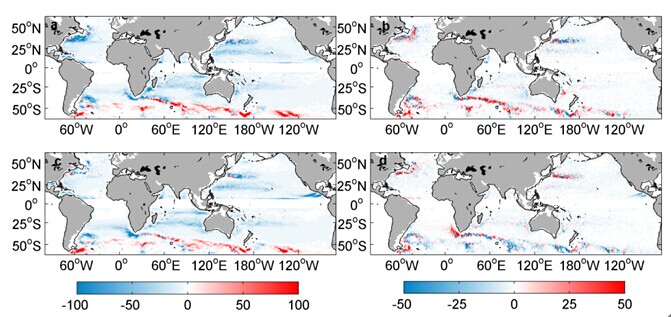Mesoscale eddies, on scales of 50 ~ 500 km, time scale of 10 ~ 100 days and with advection speed of several kilometers per day, are one of the most striking phenomenon in the world oceans. Eddy-induced mass and heat transport or other eddy-related dynamic processes are all supported by the energy contained in the eddy field. As a result, energy transport and dissipation induced by mesoscale eddies significantly impact the oceanic energy budget. Prof. Shang Xiao-Dong’s group, from the South China Sea Institute of Oceanology(SCSIO), Chinese Academy of Sciences has been working on ocean eddy energetics for many years. In 2011, they have reported their estimates of eddy energy generation/dissipation rates in the word oceans [Ocean Dynamics, 2011, 61(4): 525-541]. The group of Prof. Shang realizes that coherent mesoscale eddiesare actually serving as a kind of energy carrier or energy source for those eddy-related dynamic processes, because eddies directly or indirectly induce many effects and interactions at different scales during their propagations. Thus, to quantify this dynamically significant energy flow, researchers at SCSIO and the Woods Hole Oceanographic Institution (WHOI) estimated the multi-year averaged horizontal eddy energy fluxes (Figure below) by using satellite altimetry data and a two-layer model based on hydrographic climatology. There is a strong net westward transport of eddy energy estimated at the mean value of ~13.3 GW north of 5oN and ~14.6 GW at the band 5oS~44oS in the Southern Hemisphere. However, poleward of 44oS east-propagating eddies carry their energy eastward with an averaged net flux of ~3.2 GW. If confirmed, it would signify that geostrophic eddies not only contain the most of oceanic kinetic energy, but also carry and spread a significant amount of energy with them.
This study was published by Scientific Reports[2014, 4: 5316], an Open Access NPG journal. This work was supported financially by the Western Pacific Ocean System project (Grant XDA11010202), NationalBasic Research Program of China (Grants 2011CB403505 2013CB430303), National Natural Science Foundation of China (Grants 41306016, U103302, and 40976021) and the Grant of State Key Laboratory of Tropical Oceanography (Grant LTOZZ1304).

Figure: The multi-years averaged zonal (a, c) and meridional (b, d) components of eddy-energy flux of cyclonic eddies (a, b) and anticyclonic eddies (c, d) with lifetimes no less than 4 weeks, in unit of MW/degree. The black thin line indicates the 200-m isobath.(Image by SCSIO)